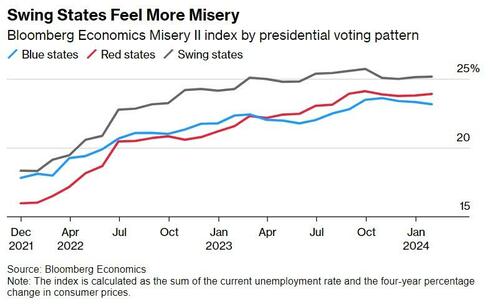US Swing States Misery Index Shows Bidenomics Is Failing
One of the most dangerous things that a government can do is present a glossy picture of the economy at a time when families and small businesses are suffering. Governments are always optimistic, but sending euphoric messages tends to backfire, especially when the situation for the middle class is complicated.
In the United States, the Biden administration’s message of “the strongest economy in decades” is not just an exaggeration; it may anger voters who suffer the burden of negative real wage growth, accumulated inflation, and higher taxes.
According to a study by the Tax Policy Center, 20 to 30 percent of middle-income households saw a tax hike in 2022 and according to the Tax Foundation, workers bear an estimated 70 percent of the corporate income tax hikes. Indirect taxation is only one source of purchasing power loss for families. Rising taxation on productive capacity reduces the availability of manufacturing jobs, limits real wage growth, and creates higher costs for consumers.
One way of measuring the situation of families in the United States is the Misery II Index, calculated as the current unemployment rate added to the accumulated consumer price index measure of inflation over the past four years. Historically, the Misery II Index, according to Bloomberg Economics, has been 17.65% in years when the current president wins an election. However, the reality of the United States economy today is much worse.
The Misery II Index for the United States stands at 23% for the whole nation, and Bloomberg Economics estimates that it will reach a staggering 24% by the time of the elections.
This means that the average US citizen has lost an enormous amount of wealth and purchasing power in salaries due to accumulated inflation, and low unemployment may not create voter support as the reality of real wage growth also shows that the average U.S. worker is struggling.
As Ryan McMaken points out, the recent minuscule increase in real wages is hardly good news when it comes after 25 months in a row of year-over-year declines in real wages from mid-2021 to mid-2023. This means that the average hourly wage has increased by just 0.76% over the past four years, when in the previous four years real wages rose three times more, or 2.8 percent.
This Misery II Index is not just bad for the whole United States. According to Bloomberg, swing-state economies have fared relatively poorly during the Biden presidency, especially since mid-2022,” with the Misery II Index for swing states almost two percentage points higher than other states.
We do not know if this will make a strong difference in voters’ decisions, but the weakening of workers’ and businesses conditions are signs of why the average American sees a much weaker economy than headlines suggest.
There is a lesson here that no government will learn. Inflationist policies never work and may make the administration lose an election. Wrongly named stimulus plans only leave a massive trail of debt and impoverishment for citizens.
The government tries to blame inflation on anything and everything except the insane fiscal and monetary policy of the past years. There is no such thing as commodity inflation, corporate greedflation, cost-push inflation, or shrinkflation. The only thing that can make aggregate prices rise in unison, consolidate the increase, and continue rising even if it is at a slower pace is the destruction of the purchasing power of the U.S. dollar through the monetary mismanagement caused by monetizing an unsustainable and ever-increasing public deficit. If any of the aforementioned factors had contributed to inflation, we would currently be experiencing deflation rather than persistent inflation, which only refers to a slower rate of price increases. Inflation is always the destruction of the purchasing power of the currency and that is what Americans received when they were promised free things: lower real wages and a diminishing purchasing power of deposit savings.
The so-called Bidemomics has brought debt to an all-time high and no real wage growth with low official unemployment that disguises labor participation and employment to population ratios below the 2019 level.
Yes, the government is to blame for inflation, and a strong economy does not show an average 0.7% real wage growth in four years, a two trillion dollar annual government deficit with $34 trillion debt, and a 17.6% accumulated official CPI inflation that is 33.7% if we consider food, 18.7% in shelter and 32.8% in energy, an estimated 30% in all non-replaceable goods, according to the Bureau of Labor Statistics 2021-2023.
Governments are to blame for inflation, and this may be a key factor in the elections.
Tyler Durden
Mon, 03/11/2024 – 14:20
via ZeroHedge News https://ift.tt/0il1meF Tyler Durden
